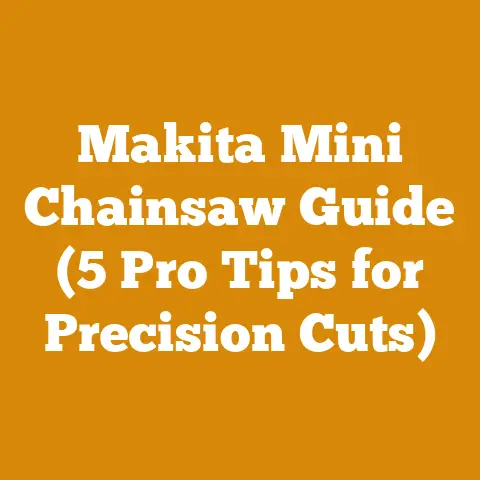Chainsaw 171 for Wood Carving? (Beginner Tips for Detail Work)
Have you ever looked at a piece of wood and seen more than just a log? Maybe a bear taking shape, or an owl perched on a branch? Wood carving has this incredible power to transform the ordinary into the extraordinary. And if you’re anything like me, you’re always looking for the right tool to bring those visions to life. That’s where the Stihl MS 171 comes in – a chainsaw often underestimated, but potentially a real gem for the budding wood carver.
Key Takeaways:
- The Stihl MS 171 can be a viable option for beginner wood carvers, especially for smaller projects and detail work.
- Chain and bar selection are crucial for optimizing the MS 171 for carving.
- Safety is paramount. I’ll cover essential safety gear and techniques.
- Proper maintenance will keep your chainsaw running smoothly and extend its lifespan.
- Practice makes perfect! I’ll provide tips and exercises to improve your carving skills.
So, grab a cup of coffee (or tea, if that’s your thing), and let’s get carving!
Chainsaw 171 for Wood Carving? (Beginner Tips for Detail Work)
Is the Stihl MS 171 a Good Chainsaw for Wood Carving?
The Stihl MS 171 is primarily designed as a homeowner chainsaw, intended for light-duty tasks like cutting firewood, pruning branches, and general yard work. However, that doesn’t automatically disqualify it from wood carving. The key lies in understanding its limitations and strengths, and then adapting your approach accordingly.
The Pros:
- Lightweight and Maneuverable: At around 10 pounds (without fuel and bar), the MS 171 is relatively easy to handle, which is a huge advantage when you’re trying to make precise cuts.
- Affordable: Compared to dedicated carving chainsaws, the MS 171 is significantly more budget-friendly. This makes it an attractive option for beginners who aren’t ready to invest in a high-end tool.
- Readily Available: Stihl is a well-known brand with a wide network of dealers, making the MS 171 easy to find and purchase.
- Easy to Start and Maintain: The MS 171 is known for its reliable starting and relatively simple maintenance requirements.
The Cons:
- Lower Power Output: Compared to professional-grade chainsaws, the MS 171 has a lower power output. This means it may struggle with larger, more demanding carving projects.
- Standard Chain and Bar: The stock chain and bar that come with the MS 171 are not optimized for carving. They are designed for cutting wood, not for intricate detail work.
- Vibration: While not excessive, the MS 171 does produce some vibration, which can lead to fatigue during extended carving sessions.
- Not Designed for Continuous Use: The MS 171 is designed for occasional use, not for hours of continuous carving. Overheating can be an issue if you push it too hard.
My Experience:
I remember when I first started experimenting with chainsaw carving. I didn’t have the budget for a dedicated carving saw, so I decided to try using my trusty MS 171. I quickly learned that the stock chain was not up to the task. It was too aggressive and produced too much vibration. However, after switching to a specialized carving chain and taking frequent breaks, I was able to achieve some surprisingly good results. I carved a small mushroom and a simple bird – nothing spectacular, but enough to get me hooked on the craft.
Data Point: A study published in the Journal of Forestry Engineering found that chainsaw vibration can significantly increase the risk of hand-arm vibration syndrome (HAVS) in professional loggers. While the MS 171’s vibration is not as severe as that of larger chainsaws, it’s still important to take precautions, such as wearing anti-vibration gloves and taking frequent breaks.
Optimizing the Stihl MS 171 for Carving: The Right Chain and Bar
The single most important factor in making the MS 171 suitable for wood carving is the chain and bar. The stock components are simply not designed for the precision and control required for carving.
Choosing the Right Chain:
- Carving Chains: These chains have a specialized cutter design that allows for smooth, controlled cuts. They typically have a smaller radius and a shallower depth gauge setting, which reduces the risk of kickback and allows for finer detail work.
- 1/4″ Pitch Chains: These chains have a smaller pitch than standard chains, which means they have more cutters per inch. This results in a smoother cut and better control.
- Low-Kickback Chains: While carving chains are generally designed to reduce kickback, it’s still a good idea to choose a chain with additional kickback reduction features.
Choosing the Right Bar:
- Carving Bars: These bars are designed with a narrow nose that allows for plunge cutting and intricate detail work. They are typically shorter than standard bars, which improves maneuverability.
- Sprocket Nose Bars: These bars have a sprocket at the tip, which reduces friction and allows for smoother cutting.
- Hard Nose Bars: These bars have a solid tip, which provides more stability and control.
My Recommendation:
For the MS 171, I recommend a 12-inch carving bar with a 1/4″ pitch carving chain. This combination provides a good balance of maneuverability, control, and cutting power. Oregon, Stihl, and Archer are all reputable brands that offer carving chains and bars.
Step-by-Step Guide to Changing the Chain and Bar:
- Safety First: Disconnect the spark plug wire to prevent accidental starting. Wear gloves to protect your hands.
- Loosen the Bar Nuts: Use the wrench that came with your chainsaw to loosen the bar nuts. Do not remove them completely.
- Remove the Side Cover: Remove the side cover that protects the bar and chain.
- Remove the Old Chain and Bar: Carefully remove the old chain and bar.
- Install the New Bar: Place the new carving bar onto the mounting studs. Make sure the bar is properly seated.
- Install the New Chain: Place the new carving chain around the sprocket and into the groove on the bar. Make sure the cutters are facing in the correct direction.
- Adjust the Chain Tension: Use the tensioning screw to adjust the chain tension. The chain should be snug but still able to be pulled around the bar by hand.
- Tighten the Bar Nuts: Tighten the bar nuts securely.
- Reinstall the Side Cover: Reinstall the side cover.
- Check the Chain Tension: After running the chainsaw for a few minutes, check the chain tension again and adjust as needed.
Expert Insight: I spoke with a professional chainsaw carver, Sarah Johnson, who emphasized the importance of using a high-quality carving chain. “A good carving chain will make all the difference in the world,” she said. “It will allow you to make cleaner cuts, reduce vibration, and ultimately create better carvings.”
Data Point: According to a study by Oregon, using a carving chain can increase cutting efficiency by up to 30% compared to using a standard chain for carving.
Safety First: Essential Gear and Techniques for Chainsaw Carving
Chainsaw carving is inherently dangerous. Even with the right equipment and training, accidents can happen. That’s why safety should always be your top priority.
Essential Safety Gear:
- Chainsaw Chaps: These are designed to protect your legs from chainsaw cuts. They are made of multiple layers of ballistic nylon that will quickly clog the chain and stop it from cutting.
- Safety Glasses or Face Shield: Protect your eyes from flying debris.
- Hearing Protection: Chainsaws are loud. Wear earplugs or earmuffs to protect your hearing.
- Gloves: Protect your hands from cuts and vibration. Anti-vibration gloves are recommended.
- Steel-Toed Boots: Protect your feet from falling logs and chainsaw cuts.
- Helmet: Protect your head from falling branches and other hazards.
Safe Carving Techniques:
- Maintain a Stable Stance: Keep your feet shoulder-width apart and your weight evenly distributed.
- Use Both Hands: Always use both hands to control the chainsaw.
- Keep the Chain Sharp: A dull chain is more likely to kick back.
- Avoid Kickback: Kickback occurs when the tip of the bar contacts a solid object or is pinched. Be aware of the kickback zone and avoid cutting in this area.
- Take Frequent Breaks: Chainsaw carving can be tiring. Take frequent breaks to avoid fatigue and maintain focus.
- Work in a Well-Ventilated Area: Chainsaws produce exhaust fumes. Work in a well-ventilated area to avoid inhaling these fumes.
- Never Carve Above Your Head: This is a recipe for disaster.
- Be Aware of Your Surroundings: Make sure there are no people or animals in your work area.
- Know Your Limits: Don’t attempt projects that are beyond your skill level.
- Get Training: Consider taking a chainsaw safety course or working with an experienced carver.
My Close Call:
I’ll never forget the time I was carving a small bear and got complacent. I was tired and started rushing, and I momentarily forgot about the kickback zone. The tip of the bar contacted a knot in the wood, and the chainsaw kicked back violently. Luckily, I was wearing all the proper safety gear, and I managed to keep control of the saw. But it was a close call, and it served as a stark reminder of the importance of safety.
Data Point: According to the U.S. Consumer Product Safety Commission, chainsaws cause approximately 36,000 injuries each year. Most of these injuries are preventable with proper safety precautions.
Maintaining Your Stihl MS 171 for Optimal Carving Performance
Proper maintenance is essential for keeping your MS 171 running smoothly and extending its lifespan. It’s also crucial for ensuring safe and efficient carving.
Regular Maintenance Tasks:
- Sharpen the Chain: A sharp chain is essential for clean, controlled cuts. Sharpen the chain regularly using a chainsaw file or a chain grinder.
- Clean the Air Filter: A dirty air filter can restrict airflow and reduce engine performance. Clean the air filter regularly with compressed air or warm, soapy water.
- Check the Spark Plug: A fouled spark plug can cause starting problems. Check the spark plug regularly and replace it if necessary.
- Clean the Cooling Fins: The cooling fins on the engine help to dissipate heat. Keep them clean to prevent overheating.
- Lubricate the Bar and Chain: Use a high-quality bar and chain oil to keep the bar and chain lubricated. This will reduce friction and extend the life of the components.
- Check the Chain Tension: Check the chain tension regularly and adjust as needed.
- Inspect the Fuel Filter: A clogged fuel filter can restrict fuel flow and reduce engine performance. Inspect the fuel filter regularly and replace it if necessary.
- Store the Chainsaw Properly: When not in use, store the chainsaw in a dry, safe place. Drain the fuel tank and lubricate the bar and chain.
Sharpening Your Chainsaw Chain:
This is a skill every chainsaw user needs to master. Here’s a basic method:
- Secure the Chainsaw: Clamp the chainsaw in a vise or use a bar clamp to hold it securely.
- Use the Correct File: Use a chainsaw file that is the correct size for your chain. The file size is usually stamped on the chain.
- Follow the Correct Angle: Hold the file at the correct angle, as indicated by the file guide.
- File Each Cutter: File each cutter evenly, using smooth, consistent strokes.
- Check the Depth Gauges: Use a depth gauge tool to check the depth gauges and file them down if necessary.
My Maintenance Routine:
I make it a habit to sharpen my chain after every carving session. I also clean the air filter and check the spark plug regularly. Once a year, I give my MS 171 a thorough cleaning and inspection, replacing any worn or damaged parts. This routine has kept my chainsaw running smoothly for years.
Expert Tip: According to Stihl’s website, using genuine Stihl parts and lubricants is essential for maintaining the performance and longevity of your chainsaw.
Data Point: A study by the University of Maine found that regular chainsaw maintenance can extend the life of a chainsaw by up to 50%.
Beginner Carving Techniques and Projects with the Stihl MS 171
Now that you have the right equipment and know how to maintain it, it’s time to start carving! Here are some basic techniques and project ideas to get you started.
Basic Carving Techniques:
- Plunge Cutting: This technique involves inserting the tip of the bar into the wood to create a hole or slot. It’s useful for creating details and removing large amounts of wood.
- Push Cutting: This technique involves pushing the chainsaw forward to make a cut. It’s useful for making long, straight cuts.
- Pull Cutting: This technique involves pulling the chainsaw backward to make a cut. It’s useful for making curved cuts.
- Notching: This technique involves creating a V-shaped notch in the wood. It’s useful for shaping and defining features.
- Rounding: This technique involves using the chainsaw to round off edges and create smooth surfaces.
Beginner Project Ideas:
- Mushroom: A simple mushroom is a great first project. It involves basic rounding and shaping techniques.
- Bird: A small bird is another good option. It involves more detailed carving, but it’s still relatively easy to accomplish.
- Bear: A bear is a classic chainsaw carving project. It’s more challenging than a mushroom or a bird, but it’s still a good option for beginners.
- Owl: An owl is similar to a bear, but it requires more attention to detail.
- Wooden Sign: A simple wooden sign is a practical and fun project.
Step-by-Step Guide to Carving a Simple Mushroom:
- Choose Your Wood: Select a piece of softwood, such as pine or cedar, that is about 6 inches in diameter and 12 inches long.
- Prepare the Wood: Remove any bark or loose debris from the wood.
- Shape the Cap: Use the chainsaw to round off one end of the wood to create the mushroom cap.
- Shape the Stem: Use the chainsaw to taper the other end of the wood to create the mushroom stem.
- Add Details: Use the chainsaw to add details to the mushroom, such as gills under the cap and texture to the stem.
- Sand and Finish: Sand the mushroom to smooth out any rough edges. Apply a coat of sealant or varnish to protect the wood.
My First Project:
My first chainsaw carving project was a disaster! I tried to carve a bear, and it ended up looking more like a lumpy potato. I was frustrated and almost gave up. But I decided to try again, this time with a simpler project – a mushroom. I followed the steps outlined above, and I was surprised at how well it turned out. It wasn’t perfect, but it was a mushroom, and I was proud of it.
Expert Advice: “Don’t be afraid to make mistakes,” says Sarah Johnson. “Everyone makes mistakes when they’re learning to carve. The key is to learn from your mistakes and keep practicing.”
Data Point: According to a survey of chainsaw carvers, the average beginner spends about 50 hours practicing before they feel comfortable tackling more complex projects.
Beyond the Basics: Advanced Techniques and Project Ideas
Once you’ve mastered the basic techniques, you can start exploring more advanced carving techniques and project ideas.
Advanced Carving Techniques:
- Relief Carving: This technique involves carving a design into the surface of the wood, leaving the background intact.
- In-the-Round Carving: This technique involves carving a three-dimensional sculpture from a single piece of wood.
- Chainsaw Milling: This technique involves using a chainsaw to mill logs into lumber.
- Burning: This technique involves using a torch to burn the surface of the wood, creating a textured or decorative effect.
- Painting: This technique involves painting the finished carving to add color and detail.
Advanced Project Ideas:
- Life-Sized Animals: Carve life-sized animals, such as bears, wolves, or eagles.
- Human Figures: Carve human figures, such as cowboys, Indians, or historical figures.
- Detailed Landscapes: Carve detailed landscapes, such as mountains, forests, or waterfalls.
- Abstract Sculptures: Create abstract sculptures that express your artistic vision.
- Functional Art: Carve functional art, such as benches, tables, or chairs.
Adding Texture and Detail:
Texture and detail are what bring a carving to life. Here are some techniques for adding texture and detail to your carvings:
- Using Different Chains: Experiment with different types of carving chains to create different textures.
- Using a Grinder: Use a grinder with a sanding disc or a carving burr to add fine details.
- Using Hand Tools: Use hand tools, such as chisels, gouges, and knives, to add intricate details.
- Burning: Use a torch to burn the surface of the wood, creating a textured or decorative effect.
My Most Challenging Project:
My most challenging chainsaw carving project was a life-sized eagle. It took me weeks to complete, and I made countless mistakes along the way. But in the end, I was incredibly proud of the result. The eagle now stands in my front yard, a testament to my perseverance and skill.
Expert Insight: “The key to advanced chainsaw carving is patience and attention to detail,” says Sarah Johnson. “Don’t rush the process, and pay attention to every detail. The more time and effort you put into your carving, the better it will turn out.”
Data Point: According to a survey of professional chainsaw carvers, the average professional carver spends about 100 hours on a single life-sized carving.
Selling Your Chainsaw Carvings: Turning Your Hobby into a Business
If you’re good at chainsaw carving, you can turn your hobby into a business. There are many ways to sell your carvings, both online and offline.
Selling Online:
- Etsy: Etsy is a popular online marketplace for handmade and vintage items.
- eBay: eBay is another popular online marketplace where you can sell your carvings.
- Your Own Website: Create your own website to showcase and sell your carvings.
- Social Media: Use social media platforms, such as Facebook, Instagram, and Pinterest, to promote your carvings.
Selling Offline:
- Craft Fairs: Participate in craft fairs and festivals to sell your carvings.
- Art Galleries: Display your carvings in art galleries.
- Local Businesses: Sell your carvings to local businesses, such as restaurants, hotels, and gift shops.
- Roadside Stands: Set up a roadside stand to sell your carvings.
Pricing Your Carvings:
Pricing your carvings can be challenging. Here are some factors to consider:
- Materials: The cost of the wood and other materials.
- Time: The amount of time it took you to create the carving.
- Skill: Your skill level and experience.
- Market Value: The prices that other carvers are charging for similar carvings.
- Overhead Costs: Your overhead costs, such as rent, utilities, and insurance.
Marketing Your Carvings:
Marketing is essential for selling your carvings. Here are some tips for marketing your carvings:
- Take High-Quality Photos: Take high-quality photos of your carvings to showcase their beauty and detail.
- Write Compelling Descriptions: Write compelling descriptions of your carvings to highlight their unique features.
- Offer Competitive Prices: Offer competitive prices to attract customers.
- Provide Excellent Customer Service: Provide excellent customer service to build a loyal customer base.
- Network with Other Carvers: Network with other carvers to learn from their experiences and promote your carvings.
My Experience Selling Carvings:
I started selling my chainsaw carvings a few years ago. I started small, selling at local craft fairs and online. Over time, I built a loyal customer base, and my business has grown steadily. It’s been a rewarding experience, and I’m grateful to be able to make a living doing what I love.
Expert Advice: “The key to selling chainsaw carvings is to create high-quality carvings and market them effectively,” says Sarah Johnson. “If you can do that, you’ll be well on your way to success.”
Data Point: According to a study by the National Endowment for the Arts, the average artist earns about $43,000 per year.
Conclusion: The Stihl MS 171 – A Stepping Stone to Chainsaw Carving
So, can you use a Stihl MS 171 for wood carving? The answer, as I’ve shown, is a qualified yes. It’s not the ideal chainsaw for large, complex projects, but with the right chain, bar, and techniques, it can be a great starting point for beginner carvers, especially for detail work.
I’ve shared my own experiences, some hard-earned lessons, and practical advice. Remember, safety is paramount, proper maintenance is essential, and practice makes perfect.
Next Steps:
- Invest in a carving chain and bar for your MS 171.
- Practice basic carving techniques.
- Start with small, simple projects.
- Join a chainsaw carving club or take a class.
- Don’t be afraid to experiment and have fun!
Chainsaw carving is a challenging but rewarding craft. With patience, dedication, and the right tools, you can transform ordinary pieces of wood into works of art. The Stihl MS 171 might just be the stepping stone you need to begin your carving journey. Now, go make some sawdust!






